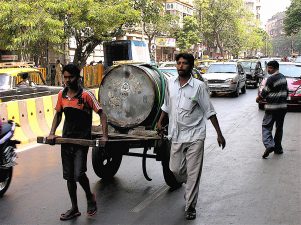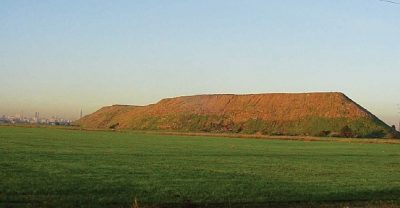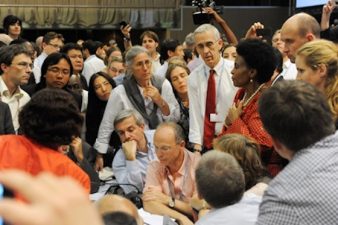 Up close and personal. Karin gets a “sniff” of sewage pipe pouring into the Jordan River. This folks, is the source of the lower Jordan River.
Up close and personal. Karin gets a “sniff” of sewage pipe pouring into the Jordan River. This folks, is the source of the lower Jordan River.
Green Prophet’s Karin and I received a real lesson in reality about the health of the Jordan River, at the Jordan River Media Tour sponsored by the Friends of the Earth Middle East (FoEME), a cross-border environmental NGO. The tour, which took place on Sunday this week was led by Gidon Bromberg, the organization’s Israel Director. He took us to see several locations of what is known as the lower part of the Jordan River, that runs from the southern end of Lake Kinneret (Sea of Galilee) more than 105 kilometers until reaching the Dead Sea. Estimates are that the Jordan River will stop running by 2011 if action isn’t taken today.
The Jordan River Media Tour included media representatives from Haaretz, Al Jazeera, the Dutch media, Sweden, Israel Channel 1, Finland, France, Spain, Austria-Germany, the UK, Ehud for the JPost, Australia, the USA , and Green Prophet.
We have both written articles about the Jordan and other environmental sites in Israel, as well as about the Dead Sea’s depletion and efforts to save it by digging the controversial “Red-Dead Canal.”
But nothing had prepared us for what we saw on Sunday.
Gidon began by saying: “What has happened to the Jordan River is definitely the result of government policies, and not the result of climate change; although climate does aggravate the situation – and is also man made”
He continued by giving us a wealth of statistics on the Jordan River’s current problems by noting who directly pollutes the Jordan. Pollution comes from the toilets of 30,000 Israelis (who channel raw sewage from Beit Shean, Tiberius, Kibbutzim and Moshavim settlements), plus 60,000 Palestinians who have no sewage treatment network and dump raw sewage in wadis and landfills that eventually reachs the Jordan. And finally, 250,000 Jordanians, who also have few sewage treatment facilities. Their sewage from wells leaks into the ground and makes its way to the river.
“Although Israel treats 70% of its own sewage, it still hasn’t done much to prevent raw sewage from being dumped ‘through the back door’ into the Jordan,” says Gidon. “Even removal of the sewage doesn’t help as the water is still very saline. The only solution is to bring in fresh water to reduce salinity levels,” he told us. What is needed to return the river to a healthy eco system is to replenish it with at least 70% fresh water and 30% recycled sewage water.
“We’re asking for a return of at least 30% of the Jordan’s former flow. Right now it’s only 2% of what it once was.”
FoEME is the only Middle East organization in the region where representatives of three countries: Israel, Jordan, and Palestine work together in full partnership. The NGO has won several environmental awards, including the Green and Black Globe environmental awards and Time Magazine Environment Hero of the year, for effectively dealing with environmental issues. It helps people of the region work together to improve the region’s water resources in peoples’ own communities.
Kasher el Yehud
The Jordan River Kaser el Yahud Baptismal site is an incredible cultural heritage site. UNESCO is going to list it as a world endangered heritage site. It’s located 422 meters below sea level, about 5 km north east of Jericho. It is the site where the Israelites are said to have crossed over into the Promised Land. Also where John the Baptist baptized Jesus.
The river was anywhere from 25 to 65 meters in width during the time when American naval officer, Lieutenant W.F. Lynch launched his expedition there in 1847, and described it as a “series of cascading rapids and water falls with rich vegetation of poplars and willows on either side.”
Now, the maximum width is around 25 meters, with a minimum of 6-7 meters. Sometimes, there is no width at all, due to it being choked with reeds (one of the few plants able to survive in the polluted, saline waters). Virtually no animal life is found in this section; with even small invertebrates not able to survive in the heavily polluted waters.
View of lower Jordan from Kaser elYehud
Kaser el Yehud (from the Israeli side) used to be a popular religious site for baptisms but now is considered a closed military zone, and was only opened briefly during the visits of Popes Benedictus XVI and John Paul II . The area is full of minefields (even in and around the river itself).
On the Jordan side, however, it is open for visits, and new churches are being built there, including a golden domed Greek Orthodox Church.
While we were there, a foreign tourist on the Jordanian side, donned a white baptismal robe and immersed himself completely in the “pure” holy waters. Gidon said a person “can get very sick by swallowing this water, or receive skin rashes if he has any broken skin areas on his body.”
The willows and poplars, described by Lynch in his journal accounts are long gone, replaced by the umbilicus reeds.
Entering the “Pure Holy Waters”
Gidon advised us that historically, Israel has taken 46% of the Jordan’s flow, with Syria taking 25% and Jordan 23%. Syria and Jordan have also dammed several streams that used to feed into the Jordan, including the Yarmuk River, now reduced to almost a trickle.
Progressing onwards toward the Kinneret, we passed a Palestinian village, Auja, where FoEME built an environmental school to teach Palestinian youth about water conservation and other environmental issues.
Most the Jordan Valley is almost devoid of wildlife, except for passing storks and other migratory birds. It’s obvious that Israeli farming in the Jordan Valley is much more sophisticated than that of Palestinians, that looked pale alongside. We saw fields of corn and banana groves, both water intensive crops, and date groves; but Gidon noted that date palms can be grown in sewage and brackish water, instead of fresh water.
Jordanian farmers (other big users of Jordan River water) seem to have no water conserving irrigation methods, and usually use sprinkler irrigation systems, which waste water. Or they flood the fields.
Crossing through checkpoint into Israel proper, landscape changed dramatically “thanks” to the use of more water resources in the Beit Shean Valley. Arriving in Beit Shean, the largest town in Jordan Valley, we were told that the Meir school there is participating in a FoEME project involving collecting rainwater from roofs, as well as collecting water from AC condensation.
“The city’s mayor finally agreed to meet with Palestinians and Jordanians to work on conserving water,” says Bromberg.
Alumot Dam
Our next stop was on a stretch of the Jordan that flows out of Lake Kinneret, known by most people outside of Israel as the Sea of Galilee.
We were told that this part of the Jordan only has a 2 km stretch of what can be called “clean water”; and it is here where Christians come from all over the world to be baptized at a site called Yardenit. We went via a small dirt and gravel road past a site where a sewage treatment was being constructed to treat raw sewage that is presently being dumped into the Jordan.
“The plant should be operating by sometime in 2011, and then most of the sewage will be treated before going into the Jordan,” Gidon said.
Gidon: “This is the Jordan’s real end”
None of us were prepared for what we would see next, when the bus reached a spot where an earthenware dam ended the river’s natural flow. Called the Alumot Dam, water is then removed from the river in large green colored pipes to be used for agriculture and other uses.
On the other side of the dam, we saw raw sewage literally spewing into what was now going to be the Jordan River until it reaches the Dead Sea. Just a few meters away was another outward flow of what our guide said was highly saline water from saline springs pulled out of the Galilee to make it more suitable potable water, and from fish ponds.
This water is diverted from the Sea of Galilee and channeled into the river. As a result, the “river” becomes a mixture of raw sewage, saline water and a bit of fresh water from the Yarmuk and other streams. In other words, the “mighty Jordan” is now nothing more than a sewage canal.
Maurice gets a wiff of “unholy sh*t”
“Since this flows into one of the world’s holiest streams, we might as well call it ‘Holy Shit’, ” Gidon mused.
Naharayim and Peace Island
After lunch at Kubbutz Nahariyim, on the lake’s southern shore, we were taken to a place known as Peace Island, which was established by the Jordanians following the peace agreement between Jordan and Israel in 1994.
Peace Island has different connotations for different people; with the saddest being the killing of a number of Israeli school girls who visited a park in 1997 that the Kibbutz had built just outside the border fence with Jordan. A Jordanian soldier went berserk and started shooting the group of kids who were in the Naharayim Peace Park, killing 7 of them.
The tragedy so upset Jordan’s King Hussein, that he paid condolence visits to several of the families of the slain girls, asking forgiveness from their parents and other relatives on bended knee.
Peace Island is located where a Jewish engineer Pinchas Rotenberg, built a hydroelectric power plant that began operation in 1932 and harnessed the water flow from a dam built across the Yarmuk River.
The dam provided electricity to both Jordan and Palestine until it was destroyed in 1948 during the War of Independence. The remains of the dam and power station are still there, as testimony to how water was used not only for agriculture but to provide clean energy as well.
Standing on the top of the island’s ridge, which includes a monument to King Hussein and tribute to his son and present king, Abdullah II, we could see the Jordan winding along below.
Lower Jordan River from Peace Island
The Yarmuk, with most of it diverted by Syria, Jordan and Israel, is here not more than a small brook, providing the lower Jordan’s main source of fresh water. It was hard to believe that there was once a lake here, with the water that ran over the dam’s spillway providing the flow to run the Rotenberg power plant.
”You can see that the Jordan below us is a very sick river, and is no longer bio-diversified. The governments of the countries that took the Jordan and Yarmuk’s water are directly to blame for this,” Gidon said.
The Three Bridges
The last stop, the Three Bridges Park by Kibbutz Gesher contains the remains of three famous bridges that once spanned the Jordan: a Roman and Mameluke one, dating back 2,000 years, an Ottoman one that once was part of a rail line that went from Haifa all the way to Damascus; and one that was built by the British. The significance of these bridges was that they all once spanned a river that was much more majestic than the pitiful, polluted stream that now flowed underneath them.
Gidon with Al Jazeera newscaster. Roman bridge is in background.
So here we were; a group of journalists who would come away from this place with a very different point of view as to what remains of a river that has had such an important role in the history of this world, and in the three great monotheistic religions of Judaism, Christianity and Islam.
Gidon ended our tour by saying that the only way to revive the Jordan, even if only by a third of its former glory, was to give it an infusion of fresh water, which will only be as a result of a reform in the water policies of Israel, Jordan and the Palestinian Authority (Syria is not counted due to its state of war with Israel).
“The governments that have ‘contributed’ to the Jordan’s demise now have to contribute to its restoration. And projects like the proposed Red-Dead Sea Canal will only make the situation worse, since the last thing the Dead Sea needs (as well as the Jordan), is more salt,” Gidon said.
::FoEME
More reading on the Jordan River:
Israel, Jordan and Palestinians meet to finalize Dead Sea Canal Plans
Bromberg Talks on Water Sustainability in the Middle East
Regional Environmentalists Meet in Amman to Save the Jordan River










Hello, i read your blog occasionally and i own a similar one and
i was just wondering if you get a lot of spam
remarks? If so how do you stop it, any plugin or anything you can suggest?
I get so much lately it’s driving me crazy so any assistance is
very much appreciated.
Also visit my web site :: 最新 スニーカー 特価, Margene,
I am sorry to have to correct a few facts here as they should not have been inserted into this report in the first place.
Firstly, there is no kibbutz Naharayim and never has been. Secondly, between the Sea of Galilee and the Dead Sea the majority of land under agriculture is on the Jordanian side that is the reason that the Jordan Valley is considered the bread basket of Jordan
Thank you for this horrifying story; so incredibly devastating to witness but hopefully with people such as your self helping to spread the word, we can make change that will stop more of this destruction.
Help save it! Vote for the Dead Sea as one of the new 7 wonders of Nature at http://www.n7w.com